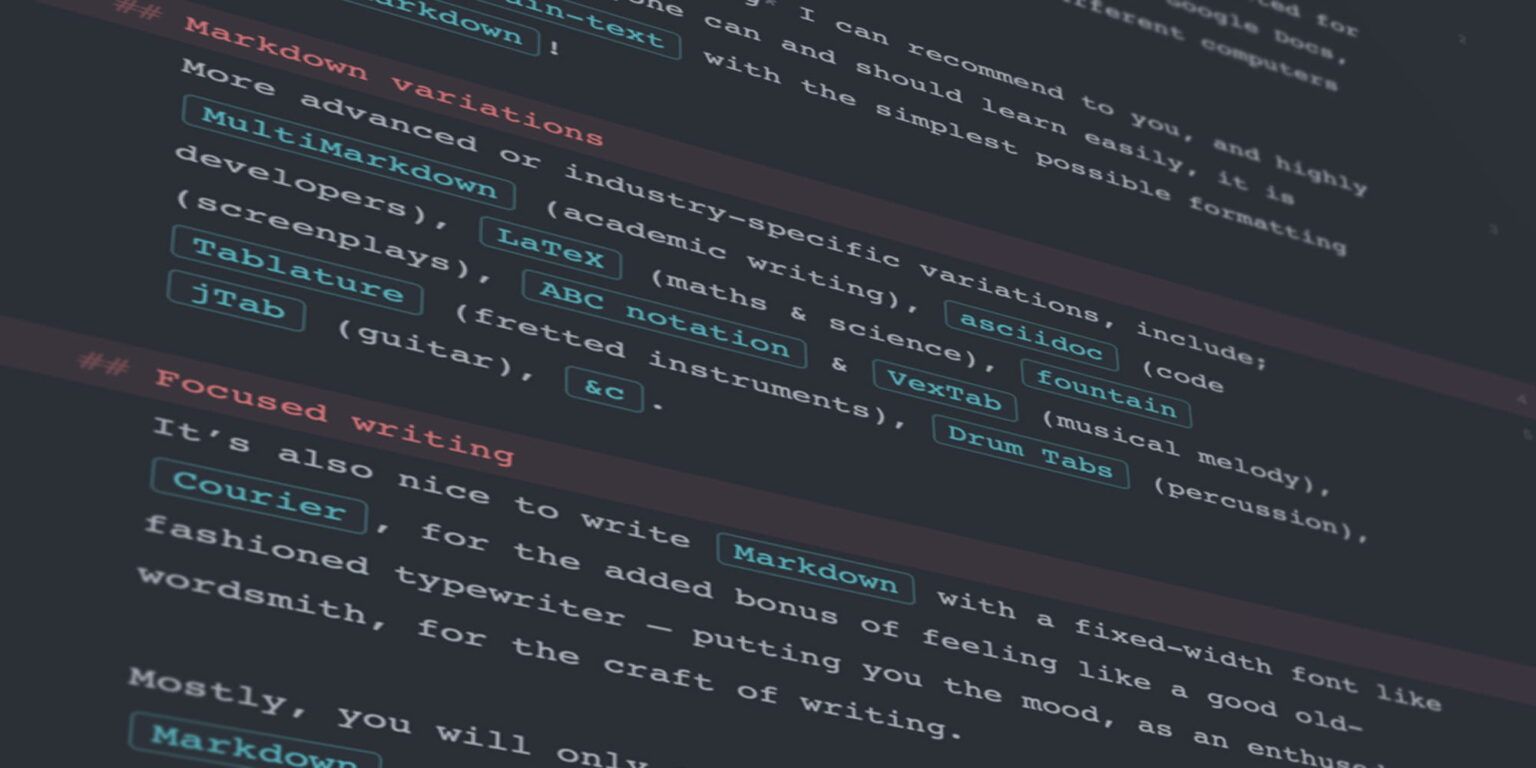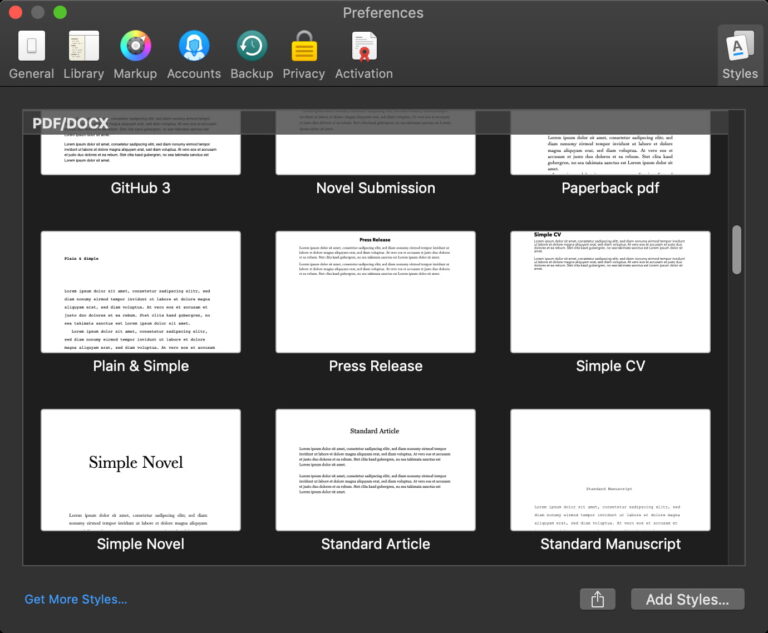Markdown: Why you should learn it, and use Plain Text files for documents #
My campaign for making plain-text writing, with Markdown, your default — so your focus is on your content — and it is never restricted for portability by proprietary software, like Word and Google Docs, where your content and formatting are tied together.

Plain Text Files
Plain text files are specified an accessible format, to ensure non-proprietary files aren’t inaccessible in communications. This is due to commercial software files being dependant upon payment, to licence their non-standards-based software, or use of services you must log in to, and agree to terms and personal data sharing.
The UK government has a policy on communication files accessibility:
You’ll most often know a plain text file from the .txt ending, perhaps a README.txt file in a software installation.
The .md extension can also be used for Markdown formatted content. It is still a plain text file that can be opened in any basic text editor.
Markdown
If there is just one thing I can recommend to you, and highly recommend that everyone can and should learn easily, it is writing in plain-text with the simplest possible formatting; Markdown!
Markdown variations
More advanced or industry-specific variations, include; MultiMarkdown (academic writing), asciidoc (code developers), LaTeX (maths & science), fountain (screenplays), ABC notation & VexTab (musical melody), Tablature (fretted instruments), Drum Tabs (percussion), jTab (guitar), &c.
Focused writing
It’s also nice to write Markdown with a fixed-width font like Courier, for the added bonus of feeling like a good old-fashioned typewriter — putting you in the mood, as an enthused wordsmith, for the craft of writing.
IA Writer has a great article specifically on the subject of fonts and their feeling in writing and publishing.
Mostly, you will only ever need plain & simple standard Markdown, as used to write this web page.
It truly is the best investment you can make in organising your notes, thoughts, and publishing — to be simple and transportable.
It’s already commonplace in academic, programmatic and creative writing. Furthermore, it is a written digital-literacy expectation, and necessity, for anyone working with subject-standardised information formatting, to work with and share.
If you work with information, it will help you. If you have knowledge to share, it will quickly broaden your horizons and potential audience. It returns your focus to the quality, insight and value of your content for your audience.
Once you have a habit of using Markdown, you will find your writing is faster, more focused — and your communication will be structured, more-so for the needs of your reader.
All you need and nothing you don’t!
It really isn’t techie or complicated, either. Actually, it is less complicated than the infinite ways that you can use traditional word-processing software — where the complexity of formatting and design options can distract from the quality and purpose of the content itself.
Markdown basics
Markdown is just a few additional characters within normal writing, in a plain-text file format, that all plain-text editors can open, edit and save.
You may already use 1. numbered lists, * bullet points, *emphasis*, **importance**, #hashtags, :emojis: and @mentions, so you’re half-way there.
There are an increasing number of applications and industries now preferring or insisting on Markdown text, because of this portability and reliability — so if you aren’t already, I hope this page gives you a good starting point.
Markdown to publishing
You can as easily export to PDF, ePub, Mobi, Kindle, DocX, Static HTML and publish to CMS Blogs like WordPress & Medium, or your own web page like this, with styling appropriate to your medium and audience.
You already type in so many ways, and on various devices, so make Markdown your default. It’s never been easier to share your knowledge, publish your ideas and build your profile as an authority on your favourite subjects!
Text editors
This is an area you might not have known you needed until you try.
Once you adjust to this way of looking at text, with a focus on the value and effectiveness of your communications, you can see how word processors can over-complicate writing, with more time spent on formatting.
Plain-text returns your focus to the successful communication of your knowledge, thoughts and creations.
If you aren’t already a convert to plain-text writing and Markdown formatting, then I hope my research into many dozens of applications, to then recommend just a few of the best for you to try, will show you by example — because their specialist subject is in offering a self-explanatory application.
It will save you time, it can both save and make you money, and will open up possibilities for you in organising your research and ideas — to then publish and share your own unique knowledge and experience with those you wish to help.
If you hadn’t guessed already, I am so confident in the value of learning this, I promise you it will be one of the best investments you ever make in what you can do with a computer. Try it! And let me know.
I’ll start with the Mac & iOS apps I use, enjoy and recommend — in approximate order of usage…
Text editors for Mac
Ulysses (Mac & iOS)
- ulysses.app
- This is my go-to do-it-all app. All writing starts here now.
- For organised Markdown, standardised noting, documenting, authoring and publishing.
- Synchronised between your computer and other devices.– I wrote this whole page in Ulysses and exported the HTML using the Ghost 2 Casper theme from the Style Library for my marcusquinn.gitlab.io eternal one-pager, and direct to this Ghost blog here.
- styles.ulysses.app
- Favourite editor style: Atom One.
- Favourite HTML styles: Ghost 2 Casper, Simplicity, Pro Sans, Medium Style, GitHub.
- Favourite PDF style: Standard Article.
- Favourite ePub styles: Simple, Amazon KDP, Gemmell Novel, Meet Charter Half Way, Medium.
Atom*
- atom.io
- This is used more commonly in code development but comparable as a text editor to Ulysses and iA Writer.
- It is vastly more powerful and extendable, although for some this might be at the expense of the focus that the above have for free-form writing, the beauty of Markdown’s simplicity, and the convenience of background syncing across devices.
- Sometimes it’s just more satisfying when the tool is designed for the job — but Atom is free, and a powerful option.
iA Writer (Mac, iOS, Windows & Android)
- ia.net/writer
- For focused writing, with a focus on focus!– Distraction-free typing, grammatical highlighting and readability statistics.
- I proofread this page in iA Writer & Hemingway App.
Scrivener (Mac, iOS, Windows & Android)
- literatureandlatte.com/scrivener/overview
- For creative writing, novels, poetry, lyrics, broadcast scripts, screenplays, thesis, journalism &c.
DEVONthink (Mac & iOS)
- devontechnologies.com/apps/devonthink
- For gathering research from many sources, in many formats, and mapping relationships between people, places and other entities.
Deckset
- deckset.com
- ulysses.app/integrations/create-beautiful-presentations-deckset
- Presentations without PowerPoint.
Velum
- vellum.pub
- Beautiful e-books & paperbacks.
Text Web Apps
For a collaborative-writing experience, similar to Google Docs and Office 365 online, and for free:
HackMD & CodiMD (Web or Self-Hosted, Collaborate)
- hackmd.io (private & public collaboration with brilliant documentation, templates and tutorials)
- demo.codimd.org (shared — and a brilliant sample reference document to learn from)
- github.com/codimd/server (self-hosting)
- Basically, Google Docs for Markdown – perfect for collaborating!– Being online-only, make sure you regularly download anything important, so you have local copies to work offline.
StackEdit (Web, Cloud Sync, Collaborate)
- stackedit.io
- Similar to HackMD & CodiMD above.
Hemingway App (Web & Mac)
- hemingwayapp.com
- Great for proof-reading.– The online version is free.
Text editors for other platforms
Followed by similar Windows & Linux apps that do almost the same thing, with of course some minor differences in features:
Joplin (Mac, Windows, Linux, iOS, Android)
- joplinapp.org
- The closest thing I could find to Ulysses on Windows, Linux, iPhone & Android.
- The only app here with encryption-at-rest, which is particularly important if handling sensitive data like; personal, medical, financial or security information.
- Doesn’t preserve file-names, so is a bit self-contained for working on files in multiple apps without copy/past or export/import.
Typora (Mac, Windows, Linux)
Zettlr (Mac, Windows, Linux)
- zettlr.com
- Similar to Ulysses & iA Writer.
- Focus on academic writing, based on the esteemed Zettelkasten method of notation & citation.
Inspire Writer (Windows-only)
- inspire-writer.com
- The best interface on Windows similar to Ulysses.
SmartEdit Writer
- atomicscribbler.com
- The closest alternative to Scrivener on Windows.
Compare Markdown Tools
There’s a lot of choice, and that’s the whole point, you can work in any or many plain-text editors with the same transportable and simplest possible file-format.
Start with the first in the list for your platform and see how you get on, if there’s something missing, try another.
Updates
If you made it this far, maybe you learned something new, and you can now do!
Subscribe for updates to this page and new posts — and let me know how you get on, or if there’s anything I can help with?
To follow my online adventures — with commentary on; creative technology, building a brand, ethical business, copywriting, ecommerce, blogging, SEO, data protection, privacy, and online security — find me on X.com…


